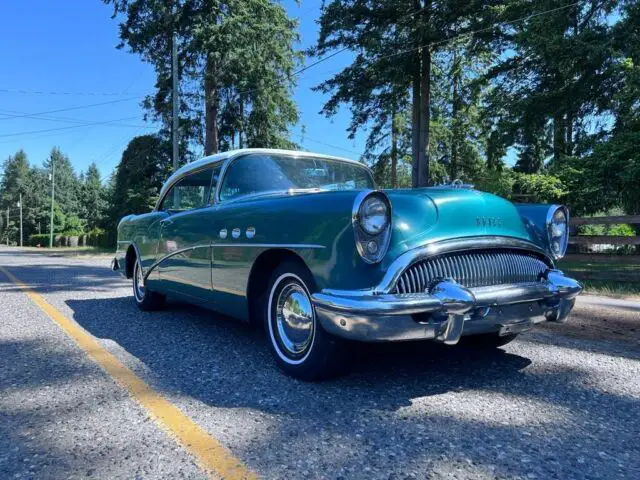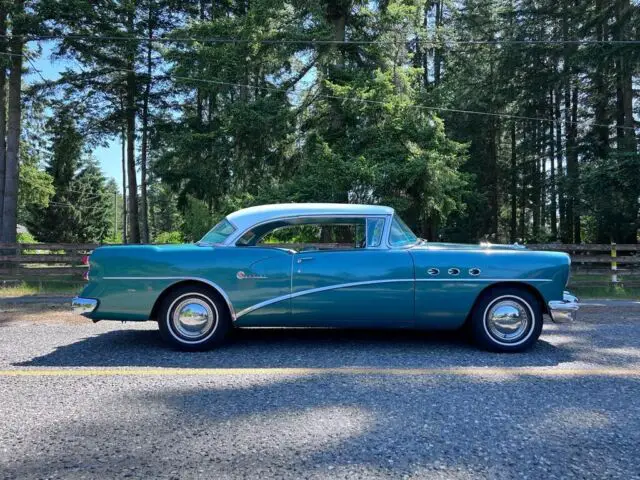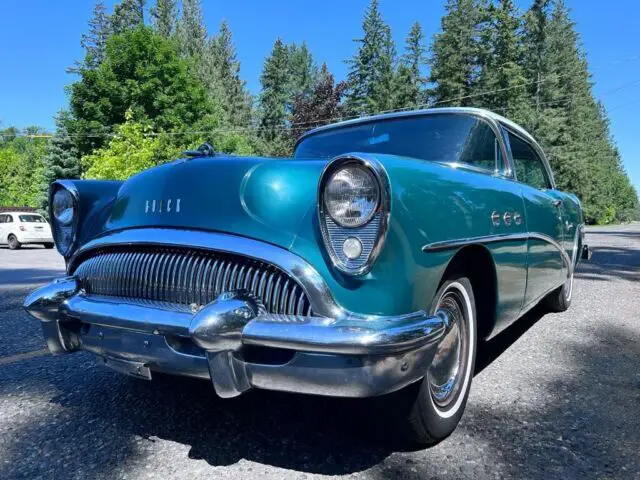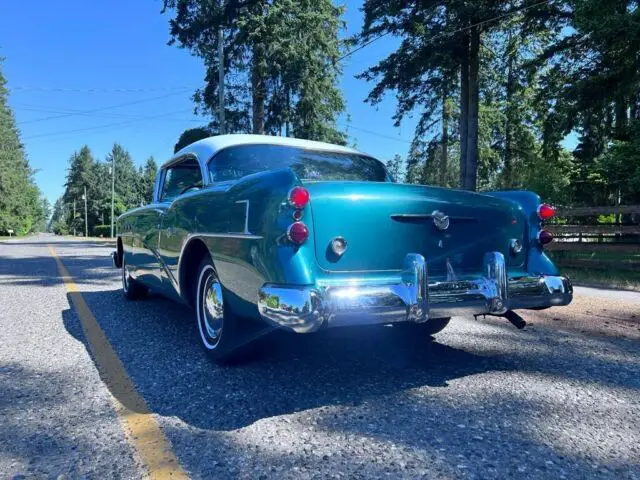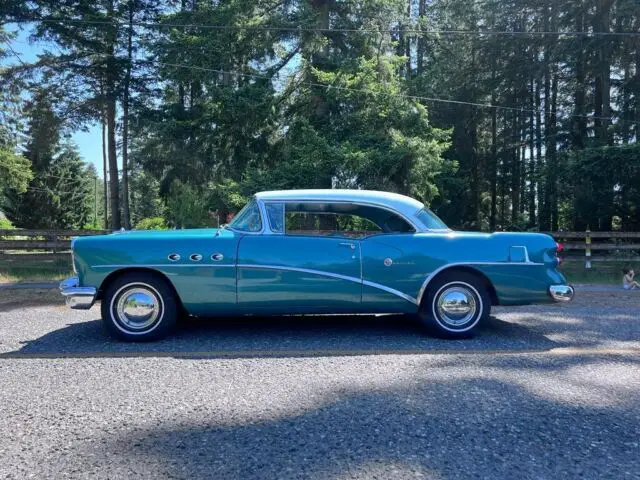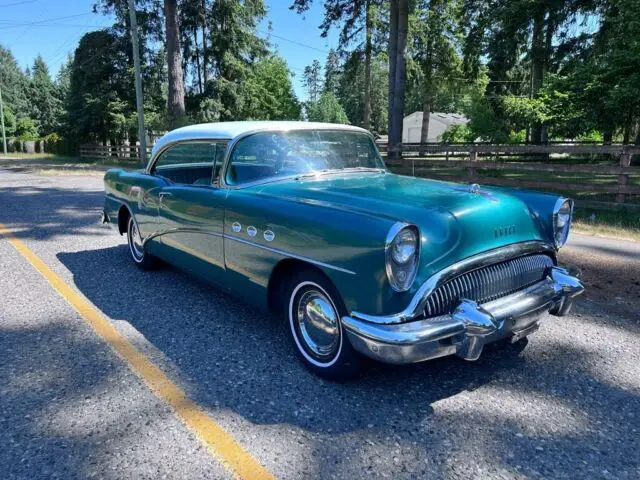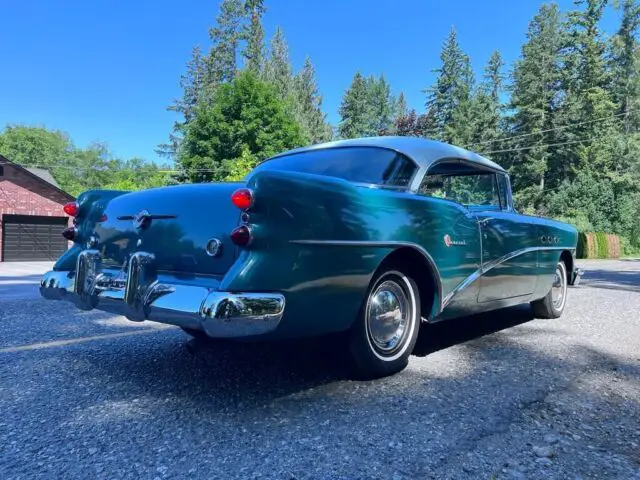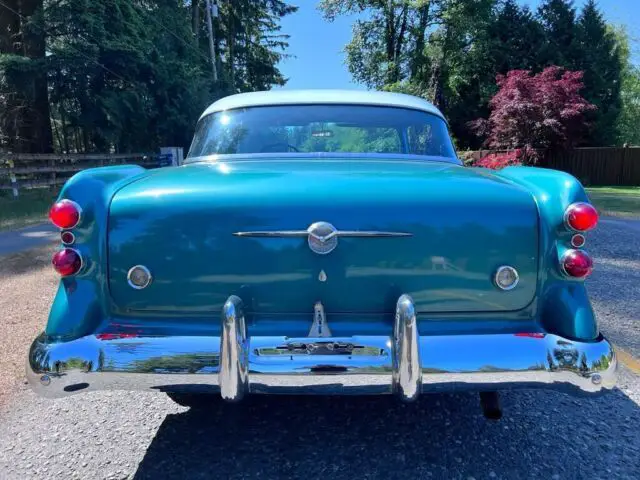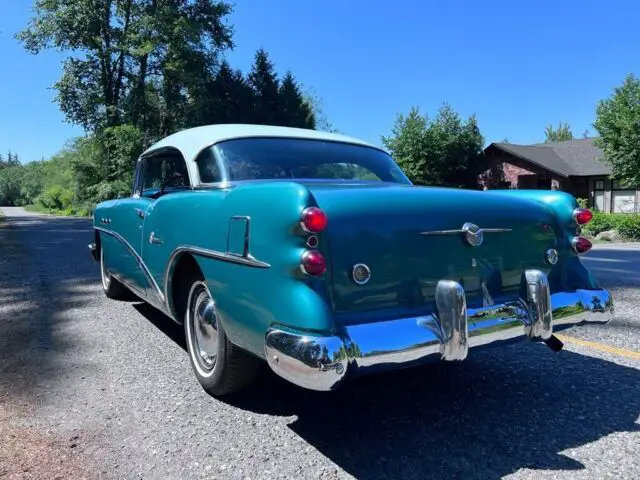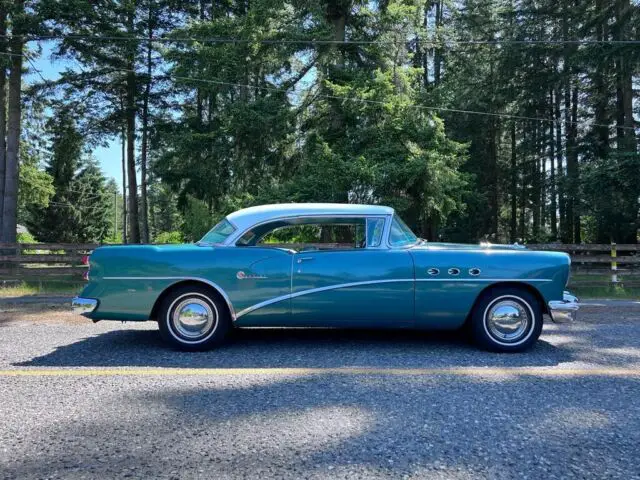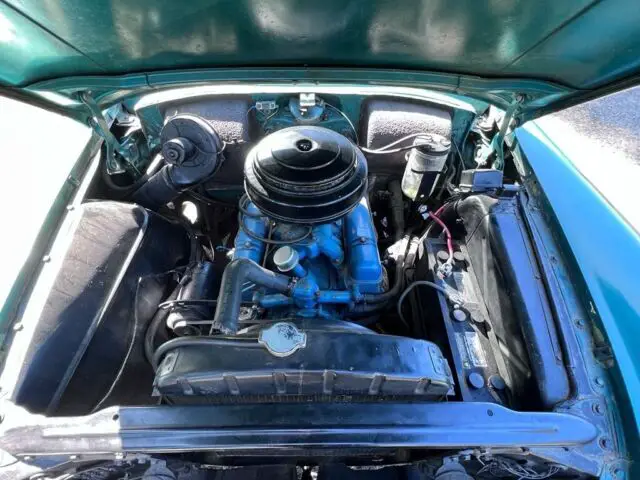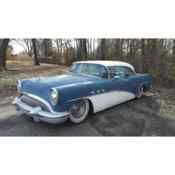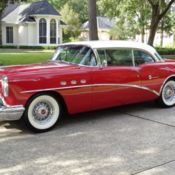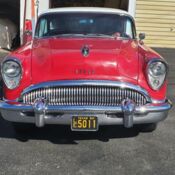1954 Buick Special Riviera
1954 Buick Special SPECIAL
1954 Buick Special- Older Restoration BeautifulSurvivor Car
- Rebuilt 264 V8 With Less Then 2000 Miles Since Rebuild
- AbsolutelyRust Free
- Dynaflow Automatic Transmission
- Great Interior "one rip in drivers seat"
- Runs & Drives Excellent !
- Green Tinted Glass All Around
- Recent Complete Tune Up
Great presentableturn key daily driver classic !
Our 54 Buick lived all of its life in a dry desert climate always very well cared and loved for, we know she will find a great new home and caretaker it deserves !
Happy Bidding !
Feel free to private message with any questions, or additional photo & video requests.
CAN ASSIST WITH SHIPPING WORLDWIDE
________________________________________________________________________________________________________
PAYMENT VIA DIRECT BANK TO BANK WIRE TRANSFER OR CASH UPON PICK UP PREFERRED
INITIAL DEPOSIT REQUIRED WITHIN 48HRS AFTER AUCTION END
FINAL PAYMENT REQUIRED WITHIN 7 BUSINESS DAYS OF AUCTION END
____________________________________________________________________________________________________________________________________________________________
CAR IS LOCATED IN CANADA (BUYER IS RESPONSIBLE FOR PICKUP/SHIPPING)
"I CAN PROVIDE ASSISTANCE WITH SHIPPING WORLDWIDE AS WELL AS INDOOR STORAGE FOR $150/MONTH UNTIL VEHICLE IS PICKED UP/SHIPPED OUT"
Although every effort is made to present accurate and reliable vehicle information, use of this information is voluntary, and should only be deemed reliable after an independent review of its accuracy, completeness, and timeliness. It is the sole responsibility of the customer to verify the existence of options, accessories and the vehicle condition before time of sale. Any and all differences must be addressed prior to time of sale. No expressed or implied warranties, including the availability or condition of the equipment listed is made. EPA mileage estimates are for comparison purposes only. Actual mileage may vary depending on driving conditions, driving habits, and vehicle maintenance.
____________________________________________________________________________________________________________________________________________________________
THE 1954 BUICK SPECIAL
Roadside America is flashing past your eyes as the wind whips through your hair; your chin sitting on your folded arms on top of the rear windowsill as you stare out the open window. The images of neon-lit diners, catchy-named motels, and split-window coupes become lost in the back of your mind as your youthful thoughts drift into the realm of the future. But something far off to the east catches your wondering eyes; a flash from the setting sun bouncing off the nose of the car traveling at you in the other lane. Lifting your head off your arms, and leaning out the window for a better glance, it becomes apparent that the mirror-like finish is the chrome on a new Buick, reflecting anything that it sees. It flashes past you like Buck Rogers on his way to another mission, and you quietly slip back to your own little world.
All that chrome so many years before had been just a small part of the redesigned Buick. Touted as "The Beautiful Buy," those three simple words in 1954 helped launch the Flint-based marque into third place in the industry with 9.65 percent of the total market. Only one year removed from their 50th anniversary, Buick's redesign had actually started to take shape four years prior, and several design cues were hinted at with the 1952 sightings of the Buick XP-300 concept car. Much of it came into fruition thanks in part to the Skylark in 1953, which would appear again in 1954, though in much smaller numbers.
Buick made more noise with the reintroduction of the Century. Built on the Special chassis, engineers dumped the larger Roadmaster V-8 under the hood, creating "one of the three fastest American stock cars" according to Floyd Clymer, capable of cruising easily at 100 mph. Four-barrel carburetors were no longer found exclusively on the Roadmaster. Yet through it all, Buick's biggest seller was once again the Special.
As had been a Buick standard for several years, four VentiPort-clad fenders indicated that the model that wore them was a Roadmaster, with three VentiPorts per fender reserved for the Special, Super and Century. However, unlike previous years, the Special did not stand alone regarding body dimensions. The small series, 122-inch wheelbase platform shared its body and trim with the new Century, while Super and Roadmaster sits on the larger 127-inch wheelbase platform.
Finally removed from the Buick horsepower lineup was the increasingly outdated 263-cu.in. straight-eight, and in its place was a new 264-cu.in. V-8, capable of either a 143hp or a 150hp rating depending on transmissions. A refined front suspension -- which could be found under the entire Buick line -- helped support the new V-8.
Exterior designs, at first glance, look to be similar to the 1953 model year in some aspects, however that quickly erodes when you start with the grille. Slimmer "teeth", and more of them, grace the continued waterfall design, while new bumper guards take on the bullet design. Turn signals still reside under the headlamps, surrounded by decorative teardrop chrome trim similar to that found on the XP-300, while a new, slim sweepspear design takes a 'V' dip, then continues aft rather than returning forward as in previous years. This new sweepspear had been found on the 1953 Skylark. The rear fender design is vastly different than 1953, with a noticeable ridge residing on top at the aft end. Model emblems are chrome with the lead letter surrounded by a circular sea of red.
The Special line outsold its sister Buicks with a total run of 190,884 units -- not including stripped chassis -- 72,254 more than the second place Super. There were five available variations offered to the buying public, the most popular of which is our featured car, the Special Riviera Hardtop with 71,186 units; second on Buick's 1954 best seller list behind 73,531 Super Riviera Hardtops. The Special Hardtop carried a base price of $2,305, certainly not the cheapest Buick. That honor went to the Special DeLuxe two-door Touring Sedan starting at $2,207. The Special DeLuxe four-door Touring Sedan started at $2,265, the Special Estate Wagon -- produced entirely out of steel for the first time -- at $3,905, and the Convertible round off the Special offerings at $2,563.
Aside from an increase of Estate Wagon production to just over 3,000 units, the Riviera hardtop was pushed hard by Buick, which set an industry record of 500,000 hardtops produced since their initial mid-year release in 1949. Another Buick landmark record was set on May 3, 1954 with the production of their two-millionth Dynaflow transmission.
ENGINES
A new V-8 offering awaited buyers after Buick's decision to nix the smaller straight-eight that had been used in 1953. In fact, there were two variations of the new 264-cu.in. powerplant, depending on which transmission had been designated to mate with it. The base offering -- with the standard three-speed transmission -- produced 143hp at 4,200 rpm from the 264, compliments of the 3.625 x 3.20-inch bore and stroke. A two-barrel Stromberg AAVB-267 carburetor fed fuel and air into the cylinders, only to find a compression ratio of 7.2:1. Hydraulic lifters were once again a Buick standard, and the torque rating stood at 228-lbs.ft. at 2,400 rpm.
The other 264 offering carries the same 3.625 x 3.20-inch bore and stroke, hydraulic lifters, and Stromberg carburetor. The difference comes in that, when mated to Buick's Dynaflow automatic transmission, the compression ratio jumps to 8.0:1, in turn increasing horsepower output to 150, and torque to 240-lbs.ft.
As with Specials of previous years, its sizable production translates into the greater possibility of finding unmolested engines in either form. The Buick engine remains virtually indestructible, if the previous owners had maintained it properly over the years. Even better, there are several companies that have been offering complete engine rebuild kits.
TRANSMISSIONS
Since its 1948 introduction, the percentage of Buicks produced with the Dynaflow transmission grew exponentially each passing year. By the time the 1954 model year rolled around, 85 percent of the Buicks produced were equipped with the automatic transmission; traditionally found as standard equipment on the Roadmaster, and available as an option in the Super, Century, and the Special. The second generation, twin-turbine Dynaflow had been introduced in time for the 1953 model year. Complicated enough to explain in detail as its own subject, the designated name given is simply due to the fact that it contains two turbines. As with the initial multi-year Dynaflow offering, rebuild kits are easily accessible, and there are rebuild specialists within the Buick collector community, if you're not comfortable tackling the job yourself. Usually bulletproof if not overheated -- hoses carry radiator coolant to the transmission, then back to the radiator, and with a heater and defroster there is about 30 feet of hose installed -- simple maintenance avoids long-term problems, and early reports of excessive fluid leaks had been resolved long before the arrival of the 1954 models.
That's not to say that Buick didn't offer a manual transmission. With the proliferation of the Dynaflow, the chances of finding any Buick with a manual transmission are somewhat slim. Truth be told, the Special, Century and Super all were offered with a Syncromesh three-speed manual transmissions as standard, as had been the case for several years, and Buick would continue to offer the three-speed as standard equipment in the Special through its model name cancellation after 1958. Our featured Special happens to house the three-speed, which is a column-shift unit freeing floor space to allow six-passenger seating. Any kinks in the armor had been eradicated with exception of wear on the clutch plate. Only second and third gears are synchronized, meaning that it may require adjustments, realignment, or worst case, replacing over time. Once again, with such a wide window of production, replacement parts can be obtained, or the unit can be sent out for rebuilding.
REAR AXLE
Once again, not unlike the engine compression ratio, the choice of transmission dictated the rear axle ratio. Power arrives at the rear axle thanks to Buick's continued use of the torque tube, ending its forward-to-aft journey at a 3.6:1 final drive ratio, if it had passed through the Dynaflow transmission. Though in the case of our featured Special equipped with the three-speed, the ratio is 3.9:1. Several pre-1954 models came equipped from the Buick assembly line with a 4.1:1 ratio, however recent owners installed the 3.9:1 ratio for better drivability in today's fast-paced highway system.
SUSPENSION
Buick's 'Million Dollar Ride' was given a slight upgrade for the 1954 editions; for the most part, entirely up front. Attached directly to the frame are the new direct-acting shock absorbers. Being independent of the springs, replacing the shocks eliminates having to realign the front end. "Finger-tip steering", according to one critic, was yet another step closer to a true reality for Buick with an upgraded steering linkage and geometry that contributed to better steering control, less strain on components and more stability while cornering.
Suspension parts are readily available, and even the continued use of the knee-action shocks in the rear suspension can be rebuilt if they have not been excessively abused over the decades.
BRAKES
Disc brakes? A long way off when it comes to Buick. Four-wheel hydraulic drums were the status quo in 1954, and power assist was an option at that, meaning you better have a decent breakfast before trying to stop nearly 4,000 pounds of rolling metal, if it's not installed. Finding a Special with power brakes might not be as daunting a task as one might think and, no matter which hydraulic system is in place, the news is even better.
Buick, for several years, used the same wheel cylinders, meaning there seems to be an endless supply of units available. Rebuild kits are rather numerous as well. Master cylinders, though not nearly as numerous, can still be found with a little effort, or a core exchange will enable you to install a freshly rebuilt unit.
New shoes are not a problem, either. Keep in mind that the front shoes have a 2.50-inch wide lining, while the rears measure 1.50 inches wide, so be sure you keep track of which set you're installing at which end.
BODY/FRAME
Buick continued to use the beefy X-frame to support their new body, which is lower to the ground than in previous years. The hood is also lower, and the trunk lid is a touch higher for a sportier look. The windshield took on a new configuration with the A pillar standing vertically on the four-door DeLuxe sedan, or a reverse angle on the rest of the Special line; effectively resulting in a wrap-around windshield.
Perhaps more striking is the new sweepspear as described earlier. Several pieces combine to make the V pattern from front to rear, however a slight difference in rear fender design may go unnoticed at first glance. The Riviera hardtops and convertibles all had a circular rear wheel opening, while the four-door models and the two-door sedan all had a squared-off rear wheel opening. This results in three different trim assembly numbers. Unfortunately for two-door DeLuxe Touring Sedan owners, it is a model by itself, sharing the sweepspear trim with no other 1954 Buick model.
Not so for the others, beginning with the other two four-door models. The Special Estate Wagon (Model 49) and DeLuxe Touring Sedan (41D) share its trim with the equivalent Century Estate Wagon (69) and the Touring Sedan (61). Two door models have more options available, thanks to the '54 Skylark having been produced on the smaller Century wheelbase. The Century two-door Riviera Hardtop (66R), Convertible (66C) and Skylark (100) trim will interchange with the Special Riviera Hardtop (46R) or Convertible (46C).
The same can be said for related body panels, with the exception of the Skylark, which lacks cutouts for the VentiPorts. Other minute details, such as the upper grille bar, will fit any 1954 model, however the outer grille bar extensions from a Roadmaster or Super will not fit the Special, Century or Skylark.
While the frame is usually found in solid condition, it's the lower body panels and rocker panels that can take a beating, especially in the traditional snow-belt regions. Floor and rocker panels are reproduced for many models, however body panels are not, and NOS panels are scarce.
INTERIOR
The Specials arrived with a nylon cloth interior, however a two-tone cloth and Cordaveen -- Buick's name for vinyl -- combination was available, except on two models. Our featured Special came standard with a two-tone interior, and the convertible arrived with leather trim. A slightly wider body means that there is a touch more interior space to be had for you and five good friends.
A new dash welcomed buyers, in some models radically different from previous years. As had been the case in prior years, the 1954 Super and Roadmaster does not share its new 'Red Line' speedometer dash with the Special or Century. Instead, two circular gauges are set into a stainless housing, with the left gauge being the speedometer and the right gauge containing the other necessary instruments such as oil and water temperatures, gas gauge and amps. Between the two is the Buick shield separating the turn signal indicators, with the marque name above, and the model name below. The radio is once again centered in the dash, with radio controls and dash-mounted ashtrays on either side. One further step to the right of the radio and you'll find the optional electric clock and the glove box at the far end. Below the right-side ashtray is the lighter.
Under the left ash tray and the right instrument cluster are the airplane-inspired controls for the vents and fan, with the optional air conditioning controls mounted below. Ignition and wiper controls straddle the steering column, and the light switch has been relocated to the left side of the dash just under the speedometer. If an optional electric antenna was installed, the toggle switch was also mounted at the bottom of the dash of the left side. One source lists the dash center panel as being painted in a cream color, while the rest matches the exterior body color, however restorations can provide much different results.
RESTORATION PARTS
Most mechanical items for many Buicks are being reproduced. But when it comes to most trim items and body panels, a little searching will be required. NOS items are harder to locate each passing day, so finding a reputable chrome shop may be a necessity. Be sure to pay close attention to your part numbers with the variation in Buick body sizes. Your best bet, as with any collector car, is to locate a master chassis and body parts book, making part number decoding much easier. They also help avoid the dreaded "it doesn't fit right" phrase during a restoration or repair.
- Make: Buick
- Model: Special
- Type: Coupe
- Trim: SPECIAL
- Doors: 2
- Year: 1954
- Mileage: 71605
- VIN: 4A2029912
- Color: Green
- Engine size: 264-cid V-8
- Number of cylinders: 8
- Fuel: Gasoline
- Transmission: Automatic
- Drive type: 2WD
- Interior color: Green
- Drive side: Left-Hand Drive
- Vehicle Title: Clean Want to buy? Contact seller!
